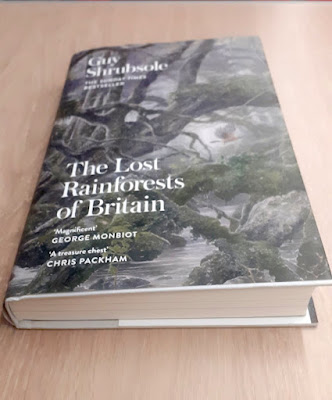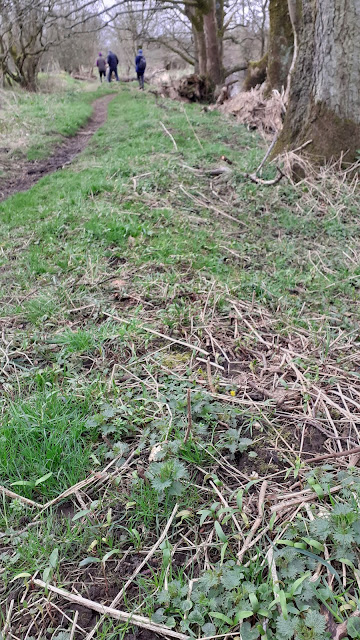If you think species should be labelled differently
please do tell me
Year 4 of my ten year lichen survey of SD86 is now up:
This post describes (with many lichen pictures at the end)
Lichens I found in three monads SD8461 SD8362 SD8363
along the road that leads east and uphill from Settle to Airton through sheep and cattle dry stone walled pastures
2 km from Settle, at 300m above sea level, (the Ribble at Settle is 145 m above sea level), and straddling the South Craven Fault.
The project - the survey of Hectad SD86 started at the end of March - 2019 as reported on 3 April 2019: Lichens Rule - at SD8060 at Rathmell.
When I find 19 species in a monad, I can colour the monad yellow in may chart. 29 species gives a colour of orange; 41 gives a colour of brown, and 56 the colour red. This is an incentive to keep looking
I am aiming to cover 10 monads per year (1 km squares) of the 100 monads in the hectad (10 by 10 km square) to at least yellow level (19 species). On Sunday 2nd April 2023 I realise I have only recorded 37 monads. (37 is not 40) and need three more monads to achieve my aim for my fourth year.. which really finished on 3 April..
So on Sun 2nd and Tuesday 4th I visit two "low hanging boughs" i.e. sites close to a road. As they are brand new monads I will have the satisfaction of getting a decent score (20 species) quickly. Then on Thurs 6th I visit the same road closer to Settle, (and with a view of the Lake District. I wave to the Cumbria Lichen - Bryophytes Group. Hi). These all lie along the South Craven Fault.
1. (*1) SD 8461 High Hill Lane stone track beside Wild Share conifer plantation on Sunday 2nd April- Gritstone drystone wall facing a scorching sunny cloudless blue sky - Only two small hawthorn bushes, by the lane. On the other side, a rather dead rowan and a young fallen, not quite dead beech tree next to the lines of recently (re) planted spruce.
Whilst foliose lichens are almost completely absent on the wall tops I do eventually tick off a few Platismatia glauca, and one Parmelia saxatilis and one Pseudevernia prunastri but no Melanelixia fuliginosa. Total lichen score: 20. (Pictures lower down)
2. (*2) SD8362 High Hill Lane tarmac road (to Airton) just before Scaleber Foss on 4 April
Dry stone wall - but what rock?
The lichens indicate limestone, but the rocks of the wall are dark red, red-brown colour and have lots of fossils. This is a completely new rock for me in this hectad.
The British Geological Society Map says the rock here is the
Bowland Shale Formation - Mudstone and siltstone. Sedimentary bedrock formed between 337 and 319 million years ago during the Carboniferous period.
The ordinary Geological survey map with its lovely shades of blue and turquoise for different limestone series that you can buy as a paper version can be viewed online here:
I see the South Craven Fault which runs through Giggleswick and Settle cuts through the rather smooth field 300 metres to the south of the road. (I suppose it is smooth because it is Bowland "SHALE". I cannot see any outcrop where this red mudstone might have come from)
There are many other small unnamed faults at the foot of High Hill (396m) to the west.
Settle Harriers and other runners will know the steep descent of High Hill in the annual Settle Hills Race.
The names for the peaks (the first two are really outcrops) as you leave Settle slightly lack imagination: Low High Hill, Middle High Hill and High Hill. No wonder their names had not sunk into my head. "Sugar Loaf Hill" 370 m - a north easterly extension of High Hill sounds a bit more impressive.
Just got side-tracked into looking at my video of the Settle Harriers "Settle Hills Race of 2019" - still it gives a good view down to the (in comparison) walls beside the rather flat mundane road I have been looking at.
There is lots of Lecanora campestris on this red mudstone. (which I have usually seen on slightly acid rocks before, or rocks as paving stones at ground level in churchyard, or with slightly basic runoff).
On some rock and moss there are big dollops of a white thick lumpy/warty lichen (not fruiting) which may be Diploschistes muscorum? I take a bit back.
My lichen score is 28.
I revisit the site two days later briefly to get the score up to 29 (which will change its colour from yellow to orange on my record chart) by looking at a north facing bit of wall to see some Opegrapha gyrocarpa. I also look unsuccessfully, for my new lichen-test bottles which I lost the day I bought them, and retreat to the car in a freezing rain shower)
I record a fourth visit to this monad on 8th April lower down this post.
3. (*3) SD8363 High Hill Lane junction with Stockdale Lane.
That brings me to the main entry for Thursday 6th April. It rains in the morning. I write and send a "Settle Events" email. I go swimming and I go and visit friends at Settle Hub, then visit Watershed Mill where I eventually buy some black shoes which look a bit like trainers but have sparkly bits on. The sun seems to be coming out. Just opportunity to start another monad. (After first revisiting Tuesday's SD8362)
This is the stretch of road nearer to Settle and adjacent to Tuesday's walk. In the junction, behind the walls are a few very tiny fenced enclosures for stock.
Here the drystone wall, and geology is similar to the previous site with lots of the red mudstone. But scattered amongst it are walling stones of gritstone, "fine sandstone Great scar limestone and a lump of concrete.
I decide I have
In the red mudstone: Verrucaria fuscella , Caloplaca flavovirescens and an intriguing Aspicialia contorta -like lichen with a yellowish thallus
On a lump of concrete on the wall top: Lecanora muralis and Caloplaca dichroa
On one (and only on this one) gritstone capstone: Parmelia saxatilis and Melanelixia fuliginosa.
(*4) Thursday's walk on 8th - A revisit to SD8362 : Sunny weather draws me back back the monad another two days later on 8th April - my fourth lichen visit in a week!
This time I go to the opposite part of the monad. From Upper Settle I drive SW, up Mitchell lane to the end of the tarmac and park, near Blacks Plantation. I walk along Lambert Lane till I enter SD8362 - a walled track that is south of the South Craven Fault on Millstone grit. - Here I think I find Trapelia placodioides and Ochrolechia androgyna (only my second record of this assuming I have made the correct identification).
The presence of a tree at last in this monad - a small stunted rowan brought to score to 42. Hurray I can change the colour of this monad on my map.
(NB for context the adjacent monad containing Scalebar Foss SD8462 has lots of geology - and in recording it over several visit last year I recorded 51 species - making that one my fourth most diverse monad.. and now this one SD8362 is my fifth equal most diverse monad. With a few more visits I should be able to get both monads up to 56 species- then they will turn red!!)

------------------------------------------------------------
1. SD 8461 High Hill Lane stone track beside Wild Share conifer plantation on Sunday 2nd April-
 |
| Hypotrachyna revoluta on branch |
 |
| Lecidella eleochroma on trunk |
 |
| Needs thought.. |
 |
| Ummm??? on gritstone |
2. (*2) SD8362 High Hill Lane tarmac road (to Airton) just before Scaleber Foss on 4 April
------
 |
View looking south to Pendle Hill (behind my topknot)
Scaleber Wood on left |
 |
| And the view north |
 |
Possibly Rhizocarpon reductum on gritstone I think
|
 |
| Aspicilia contorta with yellowish-creamish thallus between apothecia - on the red calcareous mudstone |
 |
| Close-up of Aspicilia contorta with yellowish-creamish thallus between apothecia - on the red calcareous mudstone |
 |
| Caloplaca sp. |
 |
| Close up of the same Caloplaca sp. |
 |
| View from SD towards High Hill and the slope the runners ran down. |
 |
Diploschistes muscorum?
|
 |
| The Diploschistes is growing on Cladonia |
 |
| Caloplaca flavovirescens |
 |
| Caloplaca flavovirescens |
------ |
| I take this photo of the fossil - but look closely - it is covered with a lichen |
 |
| This might be Verrucaria fuscella |
 |
| Another fossil |
 |
| and another |
 |
| Question |
 |
| Porpidia soredizodes |
SD8363 - Stockdale Land High Hill Lane Junction
 |
SD8363 - Stockdale Land High Hill Lane Junction - red calcareous mudstone
|
 |
| SD8363 - Stockdale Land High Hill Lane Junction - red calcareous mudstone |
 |
| ?Verrucaria-fuscella |
 |
| ?Verrucaria-fuscella |
 |
| The concrete lump |
 |
| Shows variety of rocks in the wall - here limestone (Reef limestone/great Scar Limestone) |
 |
| Caloplaca crenularia - a distinctive brick dark orange Caloplaca on acid rock. |
 |
| Caloplaca dichroa in the edge of the concrete |
 |
| This is the grey smooth featureless lichen that I find so often on limestone - one day I will be given a name for it. |
----------------------------------------
Back to SD8362 on 8 April-
at Lambert Lane at Mitchell Lane end - and onto gritstone - with one solitary Rowan on Track:
 |
| Entrance to SD8362. See rowan ahead. Stile is just of the left of the picture |
 |
| Trapelia placodioides |
 |
In the distance just behind and left of the tree is High Hill (in SD8363) where the runners descended on Reef limestone. (Later they would actually fun along this lane)
The tree had several foliose lichens |
 |
| Parmotrema perlatum |
Thank you for looking at the pictures.










































































